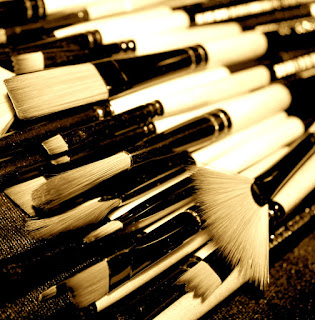We have very little of recorded history of the paint brush, considering that we know paintings existed from prehistoric era on the walls of caves, but we don't know exactly what tools were used to apply the paint. It could have been twigs, feathers, fingers or human hair.
We are, however, able to piece together a few pieces of brush history as early as the Egyptians using reeds with crushed ends. We know, too, that by the fifteenth century, paint brushes were made with quills, using either soft hairs or bristles as Cennini describes how to make them in his book, "Il Libro dell' Arte". Quills were used for several centuries for brushes, meaning the brushes could only be round. Once metal ferrules were introduced, around the industrial age, brushes could take on flat and filbert shapes. Impressionist painters were fond of the flat shape, allowing a new method of picking up and placing color on the canvas.
At one time, too, artists hand made their own brushes, just as they ground their own pigments. But as apothecaries took on supplying pigments, broom and other brush makers took on creating artist brushes. Some of the first written documents of brush-makers as a trade appeared in 1785. We know that the brush-making trade was a highly regarded vocation, with apprenticeships and unions. Brush apprentices and brush masters are still titles in the industry, with the highest quality brushes still being made by hand.
Once small companies began to produce brushes for artists, there was a growth in the brush performance and brush quality. European brush makers were known for creating some of the best natural brushes, with high quality bristles coming from Russia. It has been much more recent that bristles from China are of the highest caliber.
With the progression of technology, and concerns for the environment, synthetic hairs and the development of better synthetics has come into play in the brush making world. These synthetics have opened the door for more affordable brushes as well as qualities in the hair that natural brushes couldn't provide. Even the synthetics, though, are measured and placed by hand.
For more information on the Brush Making process, you can check out this earlier post: Look Inside the Factory
Keep Painting,
Karyn
For more brush information, check out the Dynasty Brush website.
References:
✦ Smith, Ray. "The Artist's Handbook." Alfred A. Knopf, New York, New York, 1987.
✦ Thompson, Daniel V. [Translation] "The Craftsman's Handbook 'Il Libro dell' Arte' Cennino d'Andrea Cennini". Dover Publications, New York, New York, 1954.
✦ Deutches Pinsel Und Bürstenmuseum (German Brush Museum)
We are, however, able to piece together a few pieces of brush history as early as the Egyptians using reeds with crushed ends. We know, too, that by the fifteenth century, paint brushes were made with quills, using either soft hairs or bristles as Cennini describes how to make them in his book, "Il Libro dell' Arte". Quills were used for several centuries for brushes, meaning the brushes could only be round. Once metal ferrules were introduced, around the industrial age, brushes could take on flat and filbert shapes. Impressionist painters were fond of the flat shape, allowing a new method of picking up and placing color on the canvas.
At one time, too, artists hand made their own brushes, just as they ground their own pigments. But as apothecaries took on supplying pigments, broom and other brush makers took on creating artist brushes. Some of the first written documents of brush-makers as a trade appeared in 1785. We know that the brush-making trade was a highly regarded vocation, with apprenticeships and unions. Brush apprentices and brush masters are still titles in the industry, with the highest quality brushes still being made by hand.
 |
| Master Brushmaker measuring for accuracy |
With the progression of technology, and concerns for the environment, synthetic hairs and the development of better synthetics has come into play in the brush making world. These synthetics have opened the door for more affordable brushes as well as qualities in the hair that natural brushes couldn't provide. Even the synthetics, though, are measured and placed by hand.
For more information on the Brush Making process, you can check out this earlier post: Look Inside the Factory
Keep Painting,
Karyn
For more brush information, check out the Dynasty Brush website.
References:
✦ Smith, Ray. "The Artist's Handbook." Alfred A. Knopf, New York, New York, 1987.
✦ Thompson, Daniel V. [Translation] "The Craftsman's Handbook 'Il Libro dell' Arte' Cennino d'Andrea Cennini". Dover Publications, New York, New York, 1954.
✦ Deutches Pinsel Und Bürstenmuseum (German Brush Museum)

Comments
Post a Comment